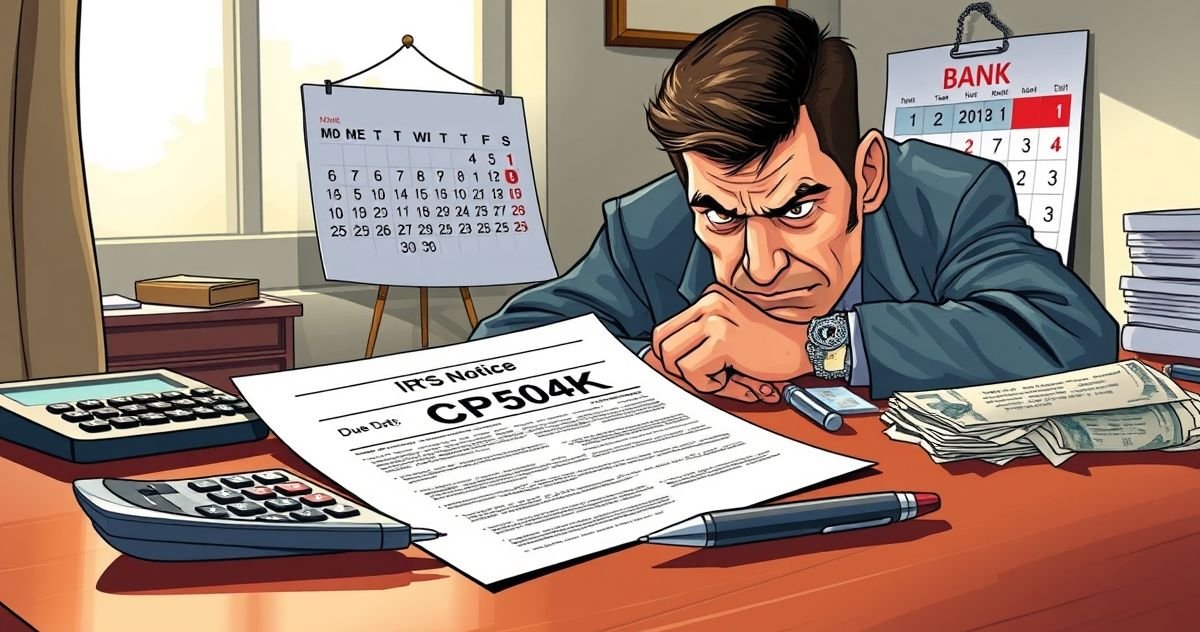Understanding the CP504K Notice
The CP504K Notice is a formal communication issued by the Internal Revenue Service (IRS) to inform taxpayers that they have a balance due in unpaid taxes and that the IRS intends to levy their assets. This notice serves as one of the final warnings before the IRS takes enforced collection actions, such as garnishing wages, placing a levy on bank accounts, or seizing other property.
What is the CP504K Notice?
The CP504K Notice is not the first communication a taxpayer will receive regarding an overdue tax balance. Preceding notices, such as the CP11 or CP14, notify the taxpayer of the initial balance and penalties. The CP504K is a much sterner warning, indicating that the IRS is ready to take further steps unless immediate payment or payment arrangements are made. It is often considered a ‘Final Notice of Intent to Levy,’ signaling that the matter has escalated.
Primary Purpose of the CP504K Notice
The main objective of the CP504K Notice is to secure payment of overdue taxes by warning the taxpayer of potential asset seizure, which may include wages, bank accounts, or other financial assets. By issuing this notice, the IRS intends to prompt serious attention from the taxpayer and encourages resolving the outstanding debt to prevent enforced collections.
Key Features of the CP504K Notice
- Balance Due: The notice clearly states the total amount of taxes owed, including any interest and penalties that have accrued to date.
- Immediate Action Required: The notice provides a due date by which payment must be made to avoid further actions. Typically, this is 30 days from the notice date.
- Levy Implications: The notice outlines the potential consequences of ignoring the demand, including wage garnishment and bank levies.
- Instructions for Payment: Detailed instructions are provided on how to make payments, including online and mail options, or how to set up a payment plan.
Compliance and Filing Requirements
Taxpayers receiving a CP504K Notice must act quickly to avoid severe penalties. Compliance involves either paying the total amount due or arranging for a payment plan with the IRS. Options available include:
- Full Payment: Pay the full amount owed by the due date detailed on the notice to avoid further action.
- Installment Agreement: Arranging a payment plan with the IRS to pay off the debt over time.
- Offer in Compromise: If eligible, taxpayers may propose settling the debt for less than the full amount due.
Penalties for Non-Compliance
Failure to resolve the debt after receiving a CP504K Notice can result in various enforced collection actions:
- Levy on Wages or Bank Accounts: The IRS can seize funds directly from your wages or bank accounts.
- Seizure of Property: The IRS may seize personal or business property to satisfy the debt.
- Additional Penalties and Interest: Further delay in payment can lead to additional penalties and interest, increasing the overall amount owed.
Importance in Financial Compliance
The CP504K Notice is of significant importance in ensuring both tax resolution and broader financial compliance. By addressing the notice promptly, taxpayers avoid the severe financial consequences of enforced collections which can have a long-term impact on their credit rating and financial health.
For those facing genuine financial hardship, the CP504K Notice also opens channels to negotiate with the IRS for more manageable payment plans, similar to an opportunity to maintain good financial standing even when facing distress. It serves as a critical juncture where taxpayers must assess their situation and choose the best path forward to meet their obligations.
Conclusion
The CP504K Notice is a critical notice that requires immediate action to prevent asset seizure and additional penalties. Taxpayers should treat it with urgency and seek ways to resolve their tax liabilities quickly, such as through payment, installment agreements, or other IRS offers. Understanding and complying with the instructions in the notice can help avoid further complications and provide relief from taxation burdens, securing a more stable financial future.



